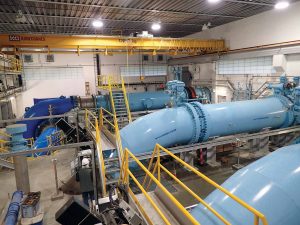
Capilano Break Head Tank and Energy Recovery Facility – Award of Excellence
December 2, 2016
By Knight Piesold
Jury Comments: “In this innovative project, the engineers met the challenge of using energy recovery while reducing the downstream water pressure in a potable water supply system. It uses a large energy recovery turbine at the terminus of a 7-km tunnel that carries treated potable water at high pressures. The energy that would otherwise be lost is expected to save Metro Vancouver 9,600 MWh a year.”

Capilano Break Head Tank plant interior, Greater Vancouver. Image: Knight Piesold.
From the October-November 2016 print issue, p. 62
The Capilano Break Head Tank and Energy Recovery Facility (BHT & ERF) is a vital link in the Seymour-Capilano Water Filtration System that supplies treated potable water to the cities of Vancouver, North Vancouver, and Burnaby.
Knight Piésold designed and commissioned the BHT & ERF, which dissipates excess energy in the water flowing from the Seymour-Capilano filtration plant and recovers that energy to generate electricity. The facility has one of the largest energy recovery turbines in a municipal treated potable water system in North America.
Located adjacent to the Capilano Reservoir and the Cleveland Dam, the facility is at the terminus of a 7-km-long, gravity-driven tunnel from the filtration plant. Because the filtration plant is 30 metres higher in elevation, the gravity-fed treated water passing through the tunnel reaches excess pressures. Knight Piésold worked closely with Metro Vancouver to create innovative solutions at the BHT & ERF. The plant enables water to be distributed to consumers in the cities, while concurrently generating electricity that partially offsets the energy consumed by one 2,000 HP pump at the Capilano Pump Station.
The new facility can either dissipate the excess water pressure through pressure reducing valves, or it can convert the excess pressure and flow into electricity through a hydroelectric turbine. This energy, which would otherwise be lost, is expected to generate enough electricity, equivalent to powering up to 1,000 homes, to reduce Metro Vancouver’s total energy consumption by approximately 9,600 MWh/year.
Pressure reducing
valves and tank
Two multi-orifice, sliding-disc-type pressure reducing valves are provided in the BHT & ERF. Each valve can deliver the full 12.5 m3/s design flow of the facility, and the control systems are fully redundant, so any single point failure will not jeopardize the continuity of the supply.
The turbine and pressure reducing valves discharge water into a large underground concrete “break head” tank. The tank is connected to the city water mains, providing a constant and seamless level of water supply to consumers.
Energy recovery turbine
The installation and commissioning of the energy recovery turbine, which has a 1.676-m diameter inlet pipe and a 4.5-m diameter spiral case, had little precedent in North America due to its size and scale.
The turbine experiences a variation of over 60% in the pressure head, which requires its controls to automatically shut the turbine down when the pressure head falls out of the allowable range. The pressure reducing valves and the turbine can operate either alone or together in order to meet varying water demands from the city.
The designers had to model tunnel and turbine surge characteristics to find operating times that prevent overpressures due to water hammer effects; these occur when the turbine rejects load. The tank has an underground overflow weir to prevent surcharging of the tank during a valve failure.
Dechlorination and environmental considerations
Given the sensitive aquatic habitat in the Capilano Reservoir, the engineers developed and upgraded a dechlorination system to treat overflow discharged into the reservoir. The dechlorination system delivers a metered dosage of calcium thiosulphate into the treated water, which neutralizes the residual chlorine, making it safe for aquatic species.
From the project’s inception Knight Piésold worked closely with Metro Vancouver and met the April 2015 deadline for delivering water.
Capilano Break Head Tank and Energy Recovery Facility,
North Vancouver, B.C.
Award-winning firm (prime design consultant/owner’s engineer): Knight Piésold (Jeremy Haile, P.Eng., Rob Adams, P.Eng., David Levi, P.Eng., Michael Pullinger, P.Eng., Marko Barisic, P.Eng., Daniel Friedman, P.Eng., Harvey Dew, P.Eng.)
Owner/client: Metro Vancouver
Other key players: CP Automation (instrumentation and controls), Gygax Engineering Associates (structural), Northwest Hydraulic Consultants (physical modeling), Arie J. Smits (architect)